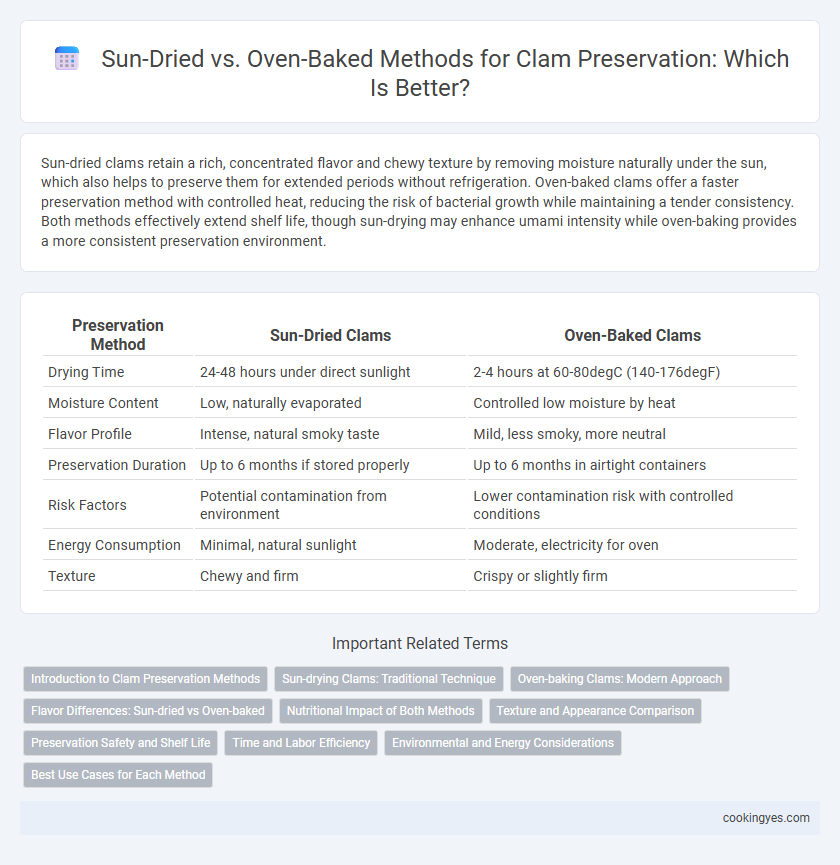Sun-dried clams retain a rich, concentrated flavor and chewy texture by removing moisture naturally under the sun, which also helps to preserve them for extended periods without refrigeration. Oven-baked clams offer a faster preservation method with controlled heat, reducing the risk of bacterial growth while maintaining a tender consistency. Both methods effectively extend shelf life, though sun-drying may enhance umami intensity while oven-baking provides a more consistent preservation environment.
Table of Comparison
| Preservation Method | Sun-Dried Clams | Oven-Baked Clams |
|---|---|---|
| Drying Time | 24-48 hours under direct sunlight | 2-4 hours at 60-80degC (140-176degF) |
| Moisture Content | Low, naturally evaporated | Controlled low moisture by heat |
| Flavor Profile | Intense, natural smoky taste | Mild, less smoky, more neutral |
| Preservation Duration | Up to 6 months if stored properly | Up to 6 months in airtight containers |
| Risk Factors | Potential contamination from environment | Lower contamination risk with controlled conditions |
| Energy Consumption | Minimal, natural sunlight | Moderate, electricity for oven |
| Texture | Chewy and firm | Crispy or slightly firm |
Introduction to Clam Preservation Methods
Sun-dried clam preservation relies on natural sunlight to reduce moisture content, effectively inhibiting bacterial growth and extending shelf life while preserving essential nutrients. Oven-baked clam preservation uses controlled heat to dehydrate the clams uniformly, minimizing moisture that can cause spoilage and ensuring a consistent texture. Both methods aim to maintain clam freshness, with sun-drying offering traditional, low-cost preservation and oven-baking providing a quicker, more controlled alternative.
Sun-drying Clams: Traditional Technique
Sun-drying clams is a traditional preservation technique that harnesses natural sunlight to reduce moisture content, effectively inhibiting microbial growth and extending shelf life. This method retains the clams' natural flavor and texture, making it preferred in coastal regions where consistent sun exposure is available. Sun-dried clams require careful monitoring to prevent contamination and ensure uniform drying, which is crucial for maintaining quality and safety.
Oven-baking Clams: Modern Approach
Oven-baking clams preserves their natural juices and enhances flavor through controlled, consistent heat, reducing moisture loss compared to sun-drying. This modern technique limits bacterial growth and extends shelf life by rapidly lowering water activity in the clam meat. Oven-baking also ensures uniform cooking, maintaining texture and nutritional value critical for high-quality clam preservation.
Flavor Differences: Sun-dried vs Oven-baked
Sun-dried clams retain a more intense and natural umami flavor due to gradual moisture loss, enhancing their briny, oceanic taste. Oven-baked clams develop a slightly caramelized, roasted profile with subtle nutty notes from faster, higher-temperature drying. Flavor nuances vary as sun-drying preserves delicate sweetness, while oven-baking intensifies savory depth through Maillard reactions.
Nutritional Impact of Both Methods
Sun-dried clams retain higher levels of protein and minerals due to slower dehydration, preserving essential nutrients while reducing moisture content. Oven-baking clams induces greater nutrient loss, particularly of heat-sensitive vitamins such as B-complex and vitamin C, because of higher temperatures and shorter cooking times. Both methods extend shelf life, but sun-drying maintains better nutritional integrity for long-term preservation.
Texture and Appearance Comparison
Sun-dried clams exhibit a chewier texture with a more concentrated flavor profile, while retaining a slightly darker, uneven appearance due to natural dehydration. Oven-baked clams maintain a plumper, firmer texture with a more uniform golden-brown color, preserving their visual appeal better for presentation. The choice between methods directly impacts the clam's surface moisture and overall mouthfeel during consumption.
Preservation Safety and Shelf Life
Sun-dried clams undergo natural dehydration under controlled sunlight, reducing moisture content to inhibit microbial growth, but may carry contamination risks if exposure is uncontrolled. Oven-baked clams provide a consistent heat treatment that effectively kills pathogens and bacteria, enhancing preservation safety and extending shelf life. Properly oven-baked clams typically maintain quality and safety for a longer period compared to sun-dried methods due to precise temperature control and reduced contamination risk.
Time and Labor Efficiency
Sun-dried clam preservation requires extended exposure to natural sunlight, often taking several days, which demands consistent monitoring and favorable weather conditions, increasing labor intensity. Oven-baked methods significantly reduce preservation time to a few hours, enabling more controlled and efficient drying with less labor input. This makes oven-baking a more time-efficient and labor-saving option for clam preservation compared to traditional sun-drying techniques.
Environmental and Energy Considerations
Sun-dried clam preservation utilizes natural solar energy, significantly reducing electricity consumption and greenhouse gas emissions compared to oven-baking methods. Oven-baked clam processing relies on consistent electrical or fuel energy, contributing to higher carbon footprints and increased operational costs. Selecting sun-drying enhances sustainability by minimizing fossil fuel dependency and promoting eco-friendly seafood preservation practices.
Best Use Cases for Each Method
Sun-dried clams are ideal for long-term storage and enhancing natural briny flavors, making them perfect for incorporation into seafood soups and stews where the intensified taste complements rich broths. Oven-baked clams retain more moisture and texture, preserving a tender bite suited for ready-to-eat dishes like clam casseroles or appetizers. Selecting sun-drying optimizes preservation by reducing moisture content, while oven-baking balances preservation with immediate culinary use.
Sun-dried vs Oven-baked for preservation Infographic

 cookingyes.com
cookingyes.com